Metris offers new reasons to tour auto show
Filed under: Weekly test drives, Autos
By John Gilbert
When the Twin Cities Auto Show arrived on the same weekend as the Minnesota state high school hockey tournament, I knew I’d find a way to get to both events, even though they are separated by the 10 miles from the Minneapolis Convention Center to St. Paul’s Xcel Energy Center ice arena.
The Twin Cities Auto Show, scheduled through March 19, is not one of the nation’s major shows, more of a dealer-oriented and operated show with vehicles contributed by the regional dealerships, and without the Detroit-Chicago-L.A.-New York displays of concept cars and futuristic things. The theme is similar, however, with an emphasis on trucks and SUVs, and reflecting the nation’s sudden urge for compact crossovers (CUV), and electrified vehicles.
The “Car of the Show” was the new Chevrolet Cruze Coupe, and after strolling through the dozens of Chevrolets looking for a two-door Cruze, I asked somebody and learned that the “Coupe” term is in roofline silhouette only, which other manufacturers call “Four-door coupe” styling.
Aside from drawing the scorn of our new President Trump for having the audacity to build the Cruze Coupe in Mexico, instead of the United States, Chevrolet has designed a winner with the Cruze Coupe, which has a neat style and a fastback roofline that ends in a hatchback.
While I never tire of strolling among a lot of new cars at any auto show, I had a couple of specific reasons for my search at the Minneapolis Convention Center. I had been doing a test drive on a 2017 Mercedes Metris that week, and I was quite curious about that vehicle, spooky as it was handling a light snowfall on top of some serious melt-then-freeze ice in my driveway.
The Metris has a front engine with rear-wheel drive, which is not the right prescription for driving through Duluth, MN., in wintertime in any reasonably competent manner. But I made it.
New Fusion adds flair with Sport model
Filed under: Weekly test drives, Autos
When the Ford Fusion was first introduced, I thought it was the most appealing design ever slapped onto the sheetmetal of a Detroit sedan. It still stirs the senses when one drives by.
For 2017, it was time for a major revision and upgrading of the Fusion, and Ford has done the job well. Particularly well, in the case of the Fusion Sport, which is a high-performance version of the venerable family sedan.
As a member in good standing of the midsize segment, which has come under heavy pressure from the enlarging gang of compacts below and the larger crossover SUVs coming at it from above. But the best midsize cars hold their own well, including the Accord, Camry, Mazda6, Altima, Sonata, Optima, Malibu, and Passat sedans == and the Fusion is right in there.
The Sport, however, is something else. Not since Ford made a top-level Taurus in high-performance SHO form has the company made such a stirring everyday driver as the Fusion Sport.
In keeping with Ford’s concept of downsizing in the engine bay, to let V6es do the job of V8s, and hot 4s replace V6es, the Fusion Sport makes top use of its EcoBoost plan to replace a solid engines with an enlivened but smaller engine, turbocharged to jack-up performance.
The garden-variety Fusion comes with your choice of a 1.5 or 2.0 liter 4-cylinders, where the 2.0 can be turbocharged to meet EcoBoost standards, plus there’s a hybrid that adds an electric motor to the 2.0’s output. Or, you can move up to the Sport.
That gets you some subtle trim touches, a neat interior, slick wheels that are 19-inchers, sportier suspension, and two major features that should leave the more mundane members of the competition wheezing and looking at the Fusion Sport’s quad tailpipes.
One of those is a twin turbocharged 2.7-liter EcoBoost V6. The 2.7 gets twin turbochargers to boost — literally — power up to 325 horsepower and 380 foot-pounds of torque. All that power makes great use of the other major feature — all-wheel drive. Read more
Audi allroad returns with all-road perfection
Filed under: Weekly test drives, Autos
By John Gilbert
A couple of decades — and an SUV craze or two — ago, a good friend of my younger son asked me how wise it would be to buy a used Audi allroad, which was a very nice and svelte station wagon-type vehicle that you could actually take off the road because of some armor-plating underneath.
Now, I’ve always been a big fan of Audi’s technology, and I’ve visited the Audi home plant in Ingolstadt, Germany, a couple of times, but I issued a word of caution to my young friend, because the word behind the scenes at that time was that Audi was going to discontinue the allroad because of slow sales. So he bought something else.
Flash forward a few years, and I saw an allroad and I realized that the drivetrain and all the mechanicals were all fine in the car, and my advice was premature for a young family in St. Paul. Now it is 2017, and while Audi is at the top of its game in competing with BMW and Mercedes for fine German car sales, I paused in my favorable impression of a new Audi A4 sedan because my test car for a mid-February week was (trumpets, please) a 2017 Audi allroad.
After this review gets filed, I’m going to notify my son’s friend and apologize for my hasty suggestion years ago, and advise him that maybe he should look anew at the allroad. Incidentally, at Audi’s insistence, allroad is spelled with a lower-case “a” just as its quattro all-wheel-drive system is spelled with a lower-case “q.” In fact, it’s amusing to note that Motor Trend, Car & Driver, and other auto publications insist on spelling it with a cap Quattro, as though that distinction makes them superior in some fashion.
The new allroad is all-new, and it is a superb vehicle, with, of course, quattro, which made confronting a Northern Minnesota snowstorm and its below-zero after-effects a simple matter, both for traction, stability, and exercising those seat-heaters.
It is based on the platform of the new A4 sedan, which has grown up in recent years with its price rising with its sophistication. It is now Audi’s base compact/midsize sedan, pushing the larger A6 and A8 up a couple of price categories. Read more
Compact crossovers rule auto-show world
Filed under: Features, Autos
By John Gilbert
CHICAGO, ILL. — The available shelf-life of an auto show is brief, but for Midwesterners who can get to the fine city of Chicago before February 20, there is a chance to turn a short trip to enjoy countless fine restaurants, nightclubs and blues joints into the chance to see all the newest stuff available from the top automakers of the world.
This may not be the most scintillating season for new vehicles, because Los Angeles and Detroit have already run their car-show course before the annual Chicago Auto Show hits McCormick Place, and most new cars have been shown already. But the nation’s best exhibition hall has a lot of things consumers will find of great interest. Mainly, the current upsurge in interest in small crossover SUVs is evident everywhere.
You can range from Ford — featuring the return of the gy-normous Expedition for large family and trailer hauling, but also tipping off its mini EcoSport, just a bit downsized from the populsr compact Escape. And the tiny but roomy C-Max which is nothing if not electrifying, remains.
The Mustang has been revised again, but its various recent styling twitches and tweaks have reached the point where a variety of them might prove impossible to discern from the others. No more V6, however, as Mustang goes from stalwart V8 to EcoBoost 4s.
KIA is showing off the all-new Stinger luxury/sports sedan in all its South Korean sleek splendor, but it also has the intriguing new Niro Hybrid compact SUV.
Toyota displays TRD sporty versions of the Tundra and Tacoma pickups and Sequoia large SUV, but finds it difficult to hide the swoopy little C-HR that starts out south of the popular RAV4 in both size and price. Its upscale Lexus display features the LS large sedan, which has taken on a much sportier demeanor, and a couple of SUVs that also play to the small but high-performance concept.
The Mazda display is easy to overlook, because the stylish group of vehicles is familiar. But they deserve scrutiny. The large CX-9 has been out a while, and the Mazda6 and Mazda3 sedans look quite the same, too, as do the new small crossovers, the CX-3 and the CX-5. The CX-5 actually is all new, and if you look closely, the red one is a red that is exclusive only to the CX-5. The true newness of all the Mazdas is something called G-Vectoring — an incredible new technological concept that gives all 2017 Mazdas the ability to tip off the driver to turn and swerve in a predictable manner that means the elimination of steering correction. The cars are beautiful, but beauty is “only” skin deep, so look closer!
Nissan, on the other hand, is leading the way in using graphic design, such as solid paint schemes of white, grey, red or black, all with stark black trim, to promote a new Midnight fleet of virtually everything it makes, from the more powerful half-ton Titan XD pickup, on down to the Rogue and all the sedans, down to the Sentra. Yet the display might be stolen by the subtly downsize Rogue Sport, which is a foot shorter than the regular Rogue. The all-new Armada stands above the other Nissans in size and capability, and a new Pathfinder, which benefits from Nissan’s new engine upgrades.
General Motors is taking a similar route, coming out with a Red Line trim feature on a large group of its vehicles. It’s a familiar idea, to use paint schemes to disguise the fact that you’ve already shown most of your stable, but of course Chevrolet has the all-electric Bolt, which continues to wrack up assorted Car of the Year awards, even though it is not yet out on the streets, and may not be until mid-summer.
Fiat Chrysler Automobiles have all sorts of new toys, featuring the Alfa Romeo Giulia — finally — and the Stelvio, which is a brother in arms with a crossover SUV so flashy that Alfa is pulling back its idea of a Giulia wagon. Also, yet another variation for the Challenger, which just introduced the AWD Challenger GT and now is hitting us with the Mopar Challenger with a giant 6.4-liter Hemi, and a Durango SRT hot rod SUV. Meanwhile, its Jeep arm displays its array and gives proper reason for why the compact Compass still exists by showing off the to-be-introduced new model with refined restyling that stays just north of the Renegade.
The Germans are not to be outdone, of course, with Volkswagen’s new Atlas large SUV as well as the Golf Alltrack and the elongated Tiguan — which will join and then probably replace the blunt but roomy-enough Tiguan, an under-appreciated vehicle that might have been well-sized for this current compact crossover trend.
BMW has its latest SUVs and also the new 5-Series, while Mercedes now has so many SUVs, crossovers and sports cars — many of them with added AMG potency — that it’s hard to find room to walk among them and identify the alphabetized nameplates that only a marketing whiz can remember.
Audi has a fine spread of Q-ship SUVs of all sizes, and sedans and coupes to seduce anyone with a tidy checkbook.
Jaguar also has a dazzling display, with its slinky coupes and new high-tech sedans, as well as the F-Pace, a hot-looking vehicle that indicates the folks at Coventry catch on when it comes to building a promising SUV. Adjoining the Jaguars is the off-road cousin Land Rover display, with new and fancy top-end SUVs and also the newly redesigned Discovery, which now has its name spelled out on the upper lip leading edge of its hood, where it used to say Land Rover.”
Subaru has a new Legacy, and it advances the company farther along the lines of being less quirky and more mainstream. Which is a good thing for Subaru, as it continues to make durable and strong flat-opposed engines that I wish would get better fuel economy.
Mitsubishi is another Japanese company that always seems to be seeking an upturn, and it now is being propped up by Nissan.Its new Outlander SUV is the only new thing, offsetting the elimination of the Lancer and its much-loved Evolution.
Hyundai is about to introduce its new Ioniq, which may indeed be iconic — or iconiq — with a choice of all-electric, hybrid or plug-in hybrid. Meanwhile, Hyundai added to its complement with the new GT version of the popular Elantra, its Civic-Corolla-Mazda3 sized compact, now with about double the high-grade steel, to 53 percent. It has a fresh new style with a hatchback-wagon theme that Hyundai designers have turned into a true sporty vehicle. So sporty, in fact, that I asked Hyundai folks why, since they offer the same 1.6-turbo 4 as the Tucson crossover, they don’t add the AWD platform under the Hyundai GT. All I got were blank stares.
But arming compacts with the very feature that is allowing compact crossovers to crowd small sedans to a lesser corner in the marketplace might be the one distinct way to fight back and change the all-out crossover SUV trend to trend of compact sedans that do the work of crossovers.
Infiniti Q50 joins world’s elite sedans
Filed under: Weekly test drives, Autos
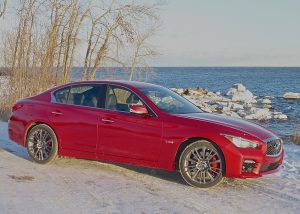
Lean and sleek styling of the new Q50 find a match in the Red Sport’s twin-turbo 3.0 V6 and AWD performance.
By John Gilbert
Even the best cars in the world are met with mixed reactions. But if no car seems capable of being all things to all customers, spend a short time with the Infiniti Q50 and you may decide it comes awfully close.
The Q50 is a sleek midsize sedan, and it can be bought in two forms, which might be considered great and greater. The top model was the one I test-drove for a week in Northern Minnesota, and it was well into winter in Duluth. Which was a good thing, for our test. The car in question was called the Q50 Red Sport 400 AWD, and it had all the goodies Infiniti could fit into that curvacious form, not the least of which was all-wheel drive.
Nissan’s potent 3.0-liter V6 is a new and high-tech powerplant that adds the extra punch of turbocharging. As in high-capacity twin turbochargers, making 400 horsepower with 350 foot-pounds of torque.
A 7-speed automatic transmission doles out all that power to the four wheels, and if you didn’t really care much for maximum fun, you could just leave it in “D” and enjoy its smooth power. Ah, but if you do enjoy driving thrills, you can shift the automatic manually with the best-designed paddle shift levers in the industry.
Companies that install paddles for fingertip shifting almost always mount them on either side of the steering wheel where they can be easily reached by thumbs, ethe right on for upshifting and left for downshifts. That works well, almost all the time.
But if you’re starting up at a T intersection, and you turn 90 degrees while accelerating, you can lose the paddle locations momentarily, usually when you shift hands, and almost always when you lost the exact location of the right paddle. Not with the Q50.
Nissan always has used long, magnesium paddles, attached to the steering column rather than the wheel. That way, if you turn the wheel hard to the left, say, and shift your hands on the wheel, as you run out of revs, you can quickly grab anywhere along the right side and you will find the paddle to upshift. Nissan uses those affixed paddles with the Infiniti Q50, meaning it begs you to shift for yourself.
When Nissan comes out with a new engine, it is always worth close scrutiny, and both engines in the Q50 are new. Without a doubt, the twin-turbo V6 boosts the Q50 to elite sports sedan prestige, comparable to, and maybe superior in some views, to BMW.
However, I am going to make a plea for anyone who is interested to first try the Q50 with the 4. It, too, is turbocharged, and even though it only has 2.0 liters of displacement, it will supply all the enthusiastic spirit you could want. The 3.0 V6 can get up to mid-30 miles per gallon in highway driving; the 2.0 turbo 4 can easily surpass and stay above 30 mpg wherever you drive.
Of course, with all-wheel drive, the Q50 AWD plowed through a 6-inch snowfall we had just up the North Shore of Lake Superior from Duluth, Minnesota, with an ease that was Jeep-like even in such foul winter weather
And here’s the less-known fact: Nissan has an arrangement with none other than Mercedes to build dual-overhead-cam, turbocharged 2.0-liter 4-cylinder engines. I spent some time with the Mercedes crossover SUVs last fall, and whether you drive the GLA, GLC, or the new GLC Coupe, as well as the C or E Class sedans, you start with a base 2.0-liter 4-cylinder turbocharged engine.
What impressed me most when I spent a week driving a Mercedes GLA was that it had plenty of punch. Its computer automatically reset itself for fuel economy each time you started up, and in a week’s time without ever getting it out for a highway road trip, I never once went anywhere up the hills of Duluth when it registered less than 32 miles per gallon.
Even more impressive, after I enjoyed the power, responsiveness and fuel-efficiency of that 4, I learned Nissan had built the engine for Mercedes. With their joint venture, some of these engines are built in various plants around the world. The 2.0 turbo 4 in the C-Class sedan is the same as the 2.0 engine built in Nissan’s Tennessee plant, while the 2.0 4 in the QX30 crossover SUV is built in Germany, then sent to the United Kingdom plant for installation.
It’s confusing, but the Infiniti engine was designed with Daimler as part of the alliance with Nissan, and while Mercedes always has had a legendary reputation with its engines, it is indeed impressive on the resume for Nissan to be building some Mercedes engines. Having the Q50, Q60, and QX30 share a 4-cylinder turbo with the C-Class, CLA, E-Class sedan and wagon, and the SLC roadster is impressive.
The 4-cylinder Q50 starts at $35,000, while the twin-turbo V6 starts at $50,700. The test car I drove had all the specialty Red Sport features. It also had hill-start assist, automatic on-off LED headlights, foglights, brake lights and turn signals. Leather trim on the seats and steering wheel set off the classy interior, which also featured Kacchu aluminum interior trim, rain-sensing wipers, power sunroof, keyless entry and push-button start, Bluetooth phone system, and Bose surround sound.
Two USB ports, cruise, voice recognition for audio, information, and Bluetooth, and the full complement of safety technology also were in place. Dynamic control, brake force distribution, traction control, tire pressure monitoring, and a vehicle immobilizer system all came standard.
The option bin produced the special Red Sport seats, matte-finish natural maple wood trim, adaptive cruise, lane-departure warning and prevention, blind spot warning, predictive collision warning, emergency braking, surround video monitor with moving object detection, backup collision intervention with rear cross-traffic alert, InTouch navigation and voice recognition, and, of course, heated front seats and steering wheel, plus remote start.
All of that lifted the price from the $50,700 Red Sport price to $62,220. That’s a long way up from the $35,000 base price for the 4-cylinder turbo Q50. Which means you can load it up any way you choose. It’s easy to become entangled in the alphabet-soup, or alpha-numeric confusion, of identifying the occupants of Nissan’s luxury branch stable, but we’re now down to the Q50, Q60 and Q70 models among the cars, where the numbers represent size, and are not to be confused with any QX things, such as QX30, QX50, QX60, QX70 or QX80 — all of which are SUVs of ever-increasing size.
As an aside, I can always be accused of favoring the most compact model of a given line, as long as it’s big enough. And in this case, it’s also true, because I found the Infiniti QX30 to be my runaway favorite among Infiniti SUVs, both because of its swoopy, low-slung styling and the inclusion of that 2.0-liter turbo 4-cylinder.
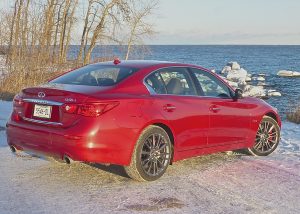
Infiniti makes larger sedans and SUVs, but the Q50 is the sportiest, and, arguably, the most attractive.
It’s hard to say whether consumers are aware of all that intermingling engine-building stuff, but Nissan’s reputation for making strong and sporty engines helped it make the largest gains in sales of any car-maker in 2016. As is the case throughout the industry, trucks led the way. Nissan sold 53,313 trucks in the U.S. in January of 2017, with the Rogue accounting for 28,760 of them, rising 46 percent. Pathfinder increased sales by 13 percent, the Quest minivan 32 percent, and the new full-size Titan pickup up by 195 percent in its reintroduction.
Nissan’s Infinity upscale brand improved SUV sales, too, and overall it increased sales by 36 percent in January 2017 compared to January 2016, with 11,558 sold. It was led by the new nQ50. One test-drive will convince you why.


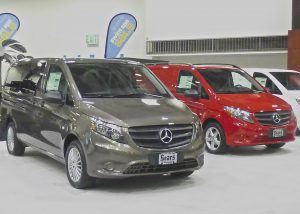
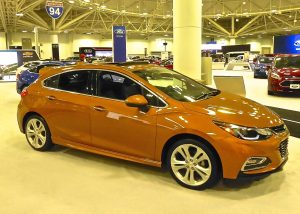

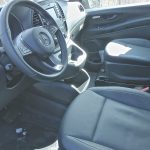

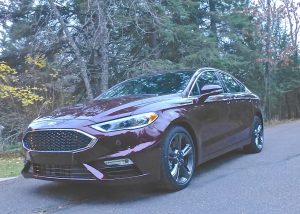
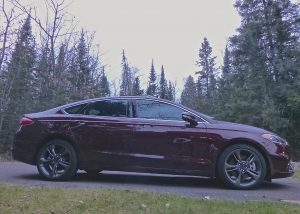
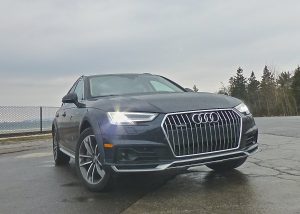
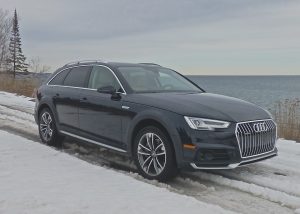
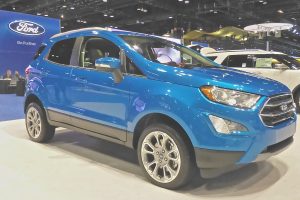
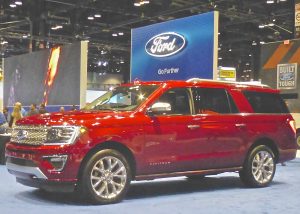

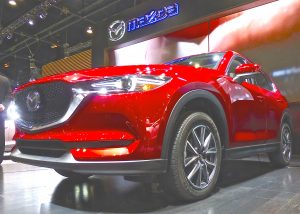
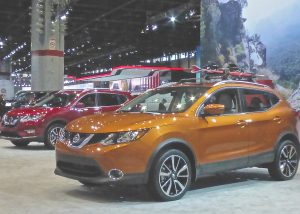
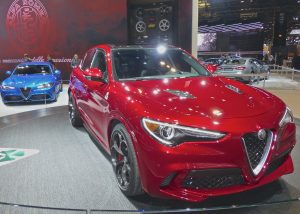
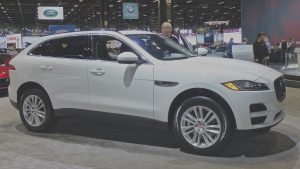
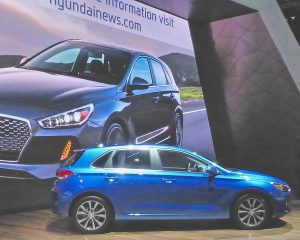
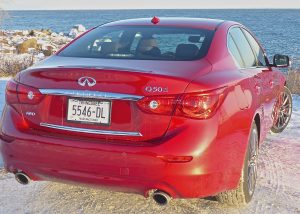
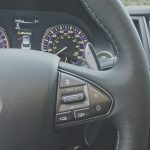
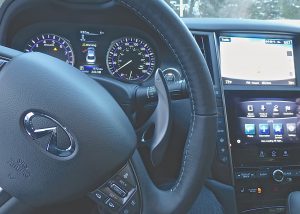
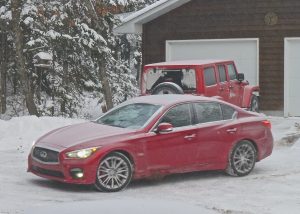
 John Gilbert is a lifetime Minnesotan and career journalist, specializing in cars and sports during and since spending 30 years at the Minneapolis Tribune, now the Star Tribune. More recently, he has continued translating the high-tech world of autos and sharing his passionate insights as a freelance writer/photographer/broadcaster. A member of the prestigious North American Car and Truck of the Year jury since 1993. John can be heard Monday-Friday from 9-11am on 610 KDAL(www.kdal610.com) on the "John Gilbert Show," and writes a column in the Duluth Reader.
John Gilbert is a lifetime Minnesotan and career journalist, specializing in cars and sports during and since spending 30 years at the Minneapolis Tribune, now the Star Tribune. More recently, he has continued translating the high-tech world of autos and sharing his passionate insights as a freelance writer/photographer/broadcaster. A member of the prestigious North American Car and Truck of the Year jury since 1993. John can be heard Monday-Friday from 9-11am on 610 KDAL(www.kdal610.com) on the "John Gilbert Show," and writes a column in the Duluth Reader.